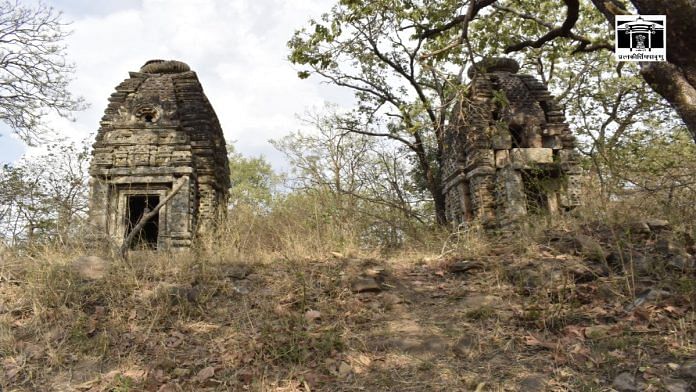New Delhi: The discovery of “remarkable archaeological remains” dating back to the 2nd Century CE in Madhya Pradesh’s Bandhavgarh Tiger Reserve has run into controversy with leading private university Ashoka claiming that it had established these findings ahead of the Archaeological Survey of India (ASI) and with differing results.
The ASI Wednesday said that in a “major find”, it had discovered 26 ancient temples and relics from ninth to 11th century CE, 26 Buddhist caves, monasteries, stupas, and Brahmi inscriptions from second to fifth century CE, along with 46 sculptures and 19 water structures (from second to 15th century CE) in the Tala range of the national park.
In Bandhavgarh Forest Reserve, remarkable archaeological remains unraveled by @ASIGoI. In an exploration 26 temples, 26 caves, 2 monasteries, 2 votive stupas, 24 inscriptions, 46 sculptures, other scattered remains & 19 water structure are recorded. (1/3) pic.twitter.com/wIZ71B5fkQ
— Archaeological Survey of India (@ASIGoI) September 28, 2022
The ASI said that the exploration of around 170 square kilometres of the Tiger Reserve “was undertaken for the first time since 1938”.
However, a team of researchers from Ashoka University had conducted an archaeological exploration of the same site over four phases, beginning March 2021 and ending in June 2022, with a paper of their findings accepted for publication in July 2022.
The paper was published in the journal Current Science on 25 September, just days before the ASI’s own announcement.
“I would like to point out that the work I led, on behalf of Ashoka University along with my students, precedes the claims of ASI as evidenced in a peer-reviewed publication that appeared in Current Science,” Nayanjot Lahiri, professor of history at Ashoka University who led the exploration, told ThePrint in an email.
“I wish that the ASI had acknowledged this fact,” she added.
Notably, the findings by the team from Ashoka University diverge from the ASI’s, particularly regarding the time of origin of the remains as well as their religious connotations.
Lahiri has written a letter to Culture Minister G Kishan Reddy expressing her concern about the lack of acknowledgement from the ASI.
Shivakant Bajpai, superintending archaeologist of the ASI Jabalpur circle, told ThePrint the ASI never claimed to be the first to discover the remains.
In addition to Ashoka, he gave the example of INTACH which has worked on the restoration of some of the sculptures in the area.
“Even in our press conference, we clearly said that other agencies have worked in the area before. This is the first time ASI has presented these findings to the public, and the first time we are finding Buddhist structures here,” he told ThePrint
He added that they are not discounting the findings of others, and that “there is no conflict, only a difference of opinion about their history”.
Also Read: Ashokan inscription, two other heritage sites in Bihar under consideration for ASI notification
Differences in the findings
The ASI recorded a total of 76 caves over a two month exploration period, with thirteen archaeologists working on the site.
Bajpai added, “We believe there are more than 100 caves in the area, which will come to light during the next phases of our exploration.”
Researchers from Ashoka University were able to identify 81, of which 44 had been marked by the forest department and 37 left unnumbered.
“Each site’s specific location and elevation were noted and subsequently, an attempt was made to see whether their entrances and front clearances could be spotted in satellite images. This was done in the hope that more cave shelters could be located by studying the pattern of the documented sites in the first phase of work,” says the Current Science paper.
Another difference between the report is the claim that the caves are Buddhist.
While the ASI’s findings state the stupas and caves are Buddhist, Lahiri said the caves cannot be tied to any particular religious community.
“If these were made for the Buddhist monastic community, there should be memorial stupas and carvings that have an overtly Buddhist character,” she said.
Lahiri argued that the structures are more reminiscent of Jaina architecture — such as those found in older archaeological sites like in Pabhosa, Uttar Pradesh.
“What the ASI calls a Buddhist stupa is not at all of the second century CE. It is a small piece which has a cylindrical form, the sort that is only seen from the fourth century CE as at the Dhamekh Stupa in Sarnath,” she explained.
According to Bajpai, the structure appears Buddhist because of its shape and components.
“Our evidence suggests it is Buddhist, and this is where the difference in our findings lies. At the moment, we are analysing the inscriptions,” he explains.
The ASI said the findings covered the reigns of indigenous kings by the names of Shri Bhimsena, Maharaja Pothasiri, Maharaja Bhattadeva. They also had inscriptions which have been deciphered as names of places.
The time period of the findings covered the reigns of the kings Shri Bhimsena, Maharaja Pothasiri, Maharaja Bhattadeva. Places deciphered in the inscriptions are Kaushami, Mathura, Pavata (Parvata), Vejabharada and Sapatanaairikaa. (2/3) pic.twitter.com/DkrGNRx0Ql
— Archaeological Survey of India (@ASIGoI) September 28, 2022
The Brahmi inscriptions about the kings had been discovered by former ASI Director General N P Chakravarti in 1938. He wrote about them in the journal Epigraphica Indica, 1955-56, according to records.
The paper published by Ashoka references Chakravarti and mentions 26 inscriptions in the Brahmi script and the kings of Kausambi but no specifics are provided.
(Edited by Theres Sudeep)
Also Read: Ashoka University student found dead outside campus, police say he consumed poison






